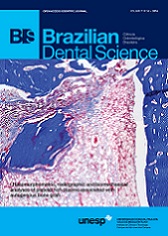Adhesion to eroded dentin submitted to different surface treatments
DOI:
https://doi.org/10.14295/bds.2014.v17i4.1029Abstract
Objective: This in vitro study measured the microshear bond strength (µSBS) of a composite resin to sound and artificially eroded dentin, submitted to surface treatment with diamond bur (DB) or Er,Cr:YSGG laser (L). Material and Methods: Bovine dentin samples were randomly divided into six groups (n=11): G1-sound dentin, G2-eroded dentin, G3-eroded dentin treated with Er,Cr:YSGG laser at 1.5W, G4-eroded dentin treated with Er,Cr:YSGG laser at 2.0W, G5-eroded dentin treated with Er,Cr:YSGG laser at 2.5W and G6-eroded dentin treated with diamond bur. Erosive cycling was performed by immersion in 0.05M citric acid (pH2.3;10min; 6x/day) and in remineralizing solution (pH7.0, 1h, between acid attacks), for 5 days. Three composite resin cylinders were bonded to the samples and after 24h storage in distilled/deionized water (37oC), samples were submitted to microshear bond strength test and mean values (MPa) were analyzed by one-way ANOVA and Tukey tests (?=0.05). Results: G1 (19.9±7.6) presented the highest µSBS mean followed by G6 (12.2±3.8), which showed no statistically significant difference compared with the other groups, except from G4. The lowest µSBS value was found for G4 (7.1±1.5), which did not differ statistically from G2 (7.5±1.8), G3 (8.4±1.8) and G5 (8.6±3.2). Analysis of the fracture pattern revealed a higher incidence of adhesive fractures for all experimental groups. Conclusion: The results indicate that Er,Cr:YSGG laser at the parameters used in this in vitro study did not enhance composite resin bonding to eroded dentin.
Downloads
Downloads
Additional Files
Published
How to Cite
Issue
Section
License
Brazilian Dental Science uses the Creative Commons (CC-BY 4.0) license, thus preserving the integrity of articles in an open access environment. The journal allows the author to retain publishing rights without restrictions.
=================




























